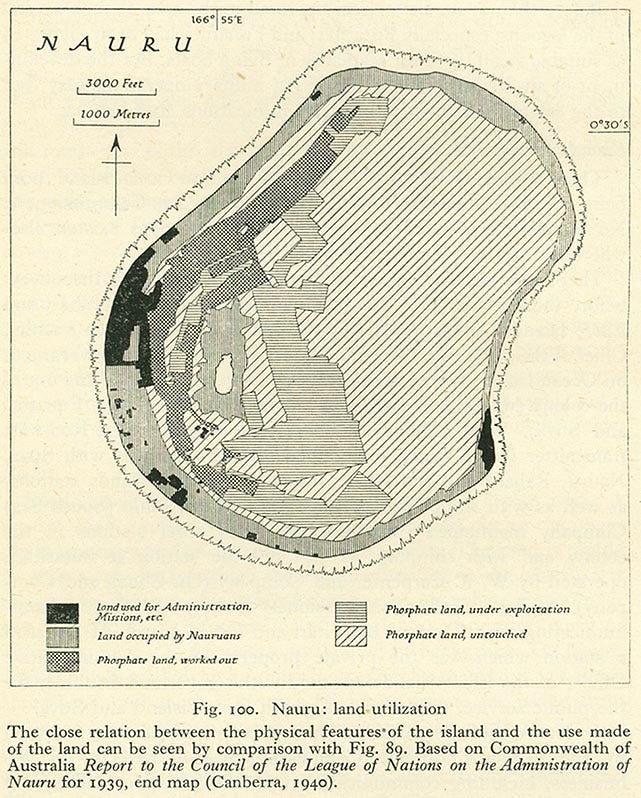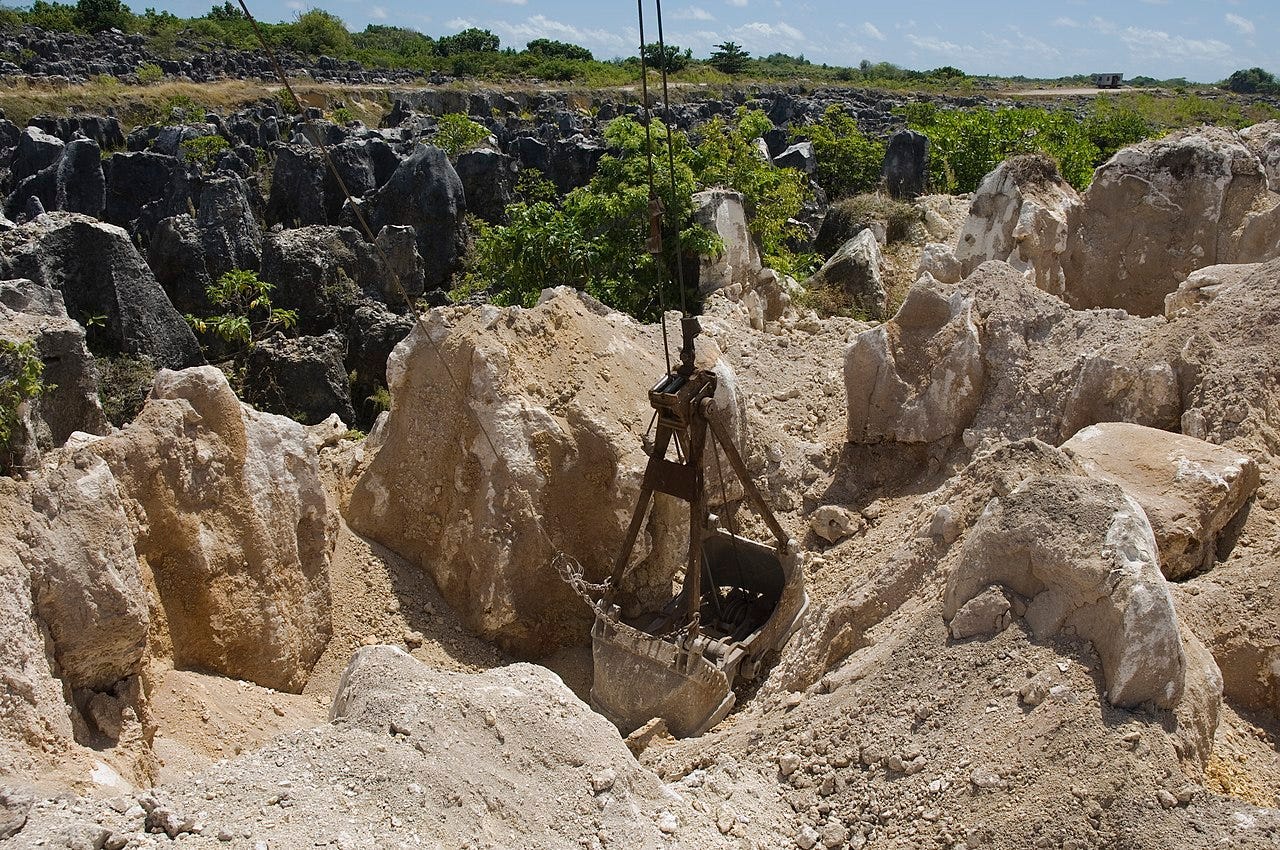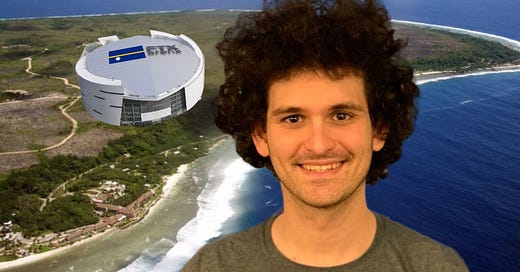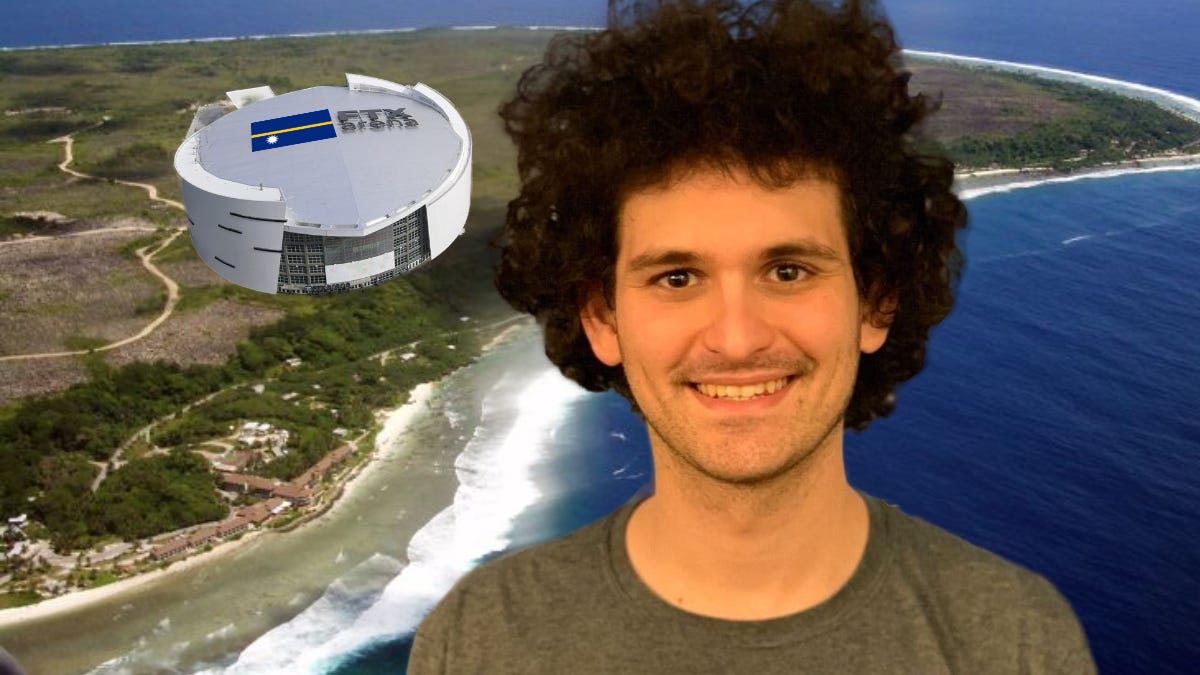The tragedy of Sam Bankman-Fried's plan to buy Nauru
The billionaire is just the latest to try to exploit the Pacific nation
Nauru is the third-smallest country in the world with a population of about 12,000 people on an island in the Pacific that’s just 8.1 mi² (21 km²). It’s a little south of the Equator, and you could be forgiven for never having heard of it until last week when it was revealed that Sam Bankman-Fried, the disgraced former CEO of crypto exchange FTX, was hoping to buy the sovereign nation to build a doomsday bunker.
Yes, you read that right. A decade ago, the tech libertarians were talking about becoming seasteaders — setting up platforms in international waters where they could live outside the laws of any state — or buying citizenship in countries like New Zealand where they might escape from social unrest in the United States. Some of them also lobbied hard to be able to set up communities within sovereign countries, but where few of the nation’s laws would apply, like Próspera in Honduras.
Bankman-Fried’s supposed plan with his brother Gabe is significantly more ambitious, and shows just how much power, wealth, and self-confidence tech billionaires have accumulated over the past decade. He wanted to purchase an entire country through the FTX Foundation, where the pair would build a bunker to be certain that if there was an “event where 50-99.99% of people die,” they could ensure “most [effective altruists] survive.”
The revelation is another knock against effective altruism (EA) too. When Bankman-Fried was on top of the world, he used the concept to frame himself as caring and empathetic; he was only making his crypto scams so he could help the world. But as his narrative has fallen apart, the EA movement — or at least its dominant branch — has been revealed as just another tech cult looking to cement its power and privilege.
The Bankman-Fried brothers didn’t just want to set up their shelter on the Micronesian nation; they also wanted to craft “sensible regulation around human genetic enhancement, and build a lab there.” In short, forwarding the larger eugenic project that’s enjoying a renaissance in Silicon Valley.
Nauru’s history of exploitation
There’s another part of this story we can’t ignore. When I read about the brothers’ scheme, the fact they targeted Nauru immediately struck me as significant. The small country has a long history of Western exploitation, beginning with its colonization by Germany in 1888, that has left it impoverished, dependent on food imports, and at the whims of wealthy benefactors for its survival. The Bankman-Frieds would’ve been just the latest to take advantage of Nauruans for their own benefit.
Central to Nauru’s history of exploitation is phosphate. The rock is mainly used in agriculture, and was first found in the interior of the small island at the beginning of the 1900s. German colonizers got a favorable contract to begin exploiting it, until the island was captured by Australia in World War I. After that time, it was under the administration of Australia, New Zealand, and United Kingdom, which extracted high levels of phosphate that they vastly underpriced to subsidize their farmers.

Peter Dauvergne, a professor at the University of British Columbia, explains that mining the resource not only failed to provide much benefit to Nauruans during that period, but destroyed the fertile interior of the island where bird species lived and much of the country’s food was cultivated. To give an idea of the effects of that extraction, he quotes Rosamond Dobson Rhone, who wrote about what she saw in Nauru in 1921.
A worked-out phosphate field is a dismal, ghastly tract of land, with its thousands of upstanding white coral pinnacles from ten to thirty feet high, its cavernous depths littered with broken coral, abandoned tram tracks, discarded phosphate baskets, and rusted American kerosene tins.
After a brief occupation by the Japanese, Australia resumed control of the island after the Second World War, along with New Zealand and the United Kingdom. They ramped up production, to the point that “more than 35 million metric tons of phosphate had left [Nauru’s] shores — enough phosphate to fill dump trucks parked end to end from New York City to Los Angeles, and back again” — by the time the country gained its independence in 1968.
Australia offered to resettle Nauruans on an island off Queensland in the 1960s and 1970s, but they declined the offer. After independence, they continued the phosphate extraction, having few other options, and for a time became fabulously wealthy. Nauru’s national trust fund, financed by resource profits, was valued at more than A$1 billion and it had the second-highest GDP per capita in the world, behind Saudi Arabia. But much of that cash was squandered by bad governance and outside actors taking advantage of the country, leaving it in dire straits by the time phosphate production began to decline.

Since then, Nauru has been jumping from scheme to scheme to try to stay afloat financially, always dependent on powerful outside forces. In the 1990s, it became a tax haven and a global center for money laundering, with plenty of Russian money flowing through the island. Then, in the 2000s, it agreed to host an offshore detention camp for Australia as the country cracked down on migration by boat. The Australian policy was found to be illegal and detainees were held in deplorable conditions, with outcomes that included severe trauma for children. The detention camp was finally wound down earlier this year, leaving the country once again in search of income.
Enabling deep-sea destruction
Nauru’s most recent poorly considered endeavor is deep-sea mining. In 2021, it used a loophole to force the International Seabed Authority (ISA) to develop a regulatory framework for the practice within two years. That deadline passed last month with no rules in place, and despite pushback from environmental groups, marine scientists, and other Pacific nations, Nauru plans to charge forward.
Margo Deiye, the country’s ambassador to the ISA, says deep-sea mining is a necessity for Nauru as income from phosphate mining and holding Australian’s unwanted refugees dwindles. She’s been greenwashing the practice as essential for climate action by providing the resources to accelerate electrification, which is debatable at best. As the US has ramped up its campaign against China, the argument that deep-sea mining will allow the West to build a mineral supply chain beyond Chinese control has also been deployed by advocates.
We don’t need new tech to fight climate change
But this isn’t about enriching little Nauru or helping the planet. Canada-based The Metals Company (TMC; formerly DeepGreen) is using the desperation of the island nation to get it to force a deep-sea mining industry into being for the company’s benefit. Maureen Penjueli, the executive director of the Pacific Network on Globalisation, told Mongabay that the country’s history makes it “very easy prey for multinational companies such as DeepGreen, who are quite aware of this kind of desperate positioning of countries like Nauru.”
There’s long been controversy over TMC’s relationship with the ISA and the privileged access to information it’s received. Last year, the New York Times reported that despite the claims of helping an impoverished nation, TMC “maintained nearly complete financial control over the project, including rights to all but a fraction of the anticipated profits.” A community leader in Tonga told the journalists that TMC had agreed to pay a $2 per ton “mining production fee,” which amounts to “less than half of one percent of the firm’s total estimated value of the mined material.”
The problem with tech billionaires
Once again, Nauruans are being swindled by outsiders, but what does that have to do with the Bankman-Fried brothers and the wider tech industry? The story of their desire to buy a sovereign country and use it for their apocalypse fantasies and eugenicist dreams tells us a lot about the current state of Silicon Valley.
After several decades of being held up as more socially conscious than the old guard of corporate America, that mask has been ripped off as the people at the top of the tech industry have shown their true colors in the past few years. The power and wealth they accumulated during the post-internet boom has quite clearly gone to their heads, and they now feel they’re not only above the rules, but should be able to actively shape the entire world to work in whatever way works best for them.
Why Silicon Valley is bringing eugenics back
Nauru is a tragic example of what happens when decisions are left to powerful forces that ultimately have their own interests in mind. Despite claiming to be effective altruists, the Bankman-Frieds didn’t seem fazed by the idea of buying a country, then treating it as a billionaires’ playground while its 12,000 struggling residents surrounded them. It aligns not just with the tech libertarian fantasies of escape, but billionaire longtermists like Elon Musk who feel suffering in the present is justified as long as they can feel like they’re shaping the far future of the entire human species.
The Bankman-Frieds’ dream for a Pacific bunker and the longer history of Nauru’s exploitation show exactly why Silicon Valley billionaires and every exploitative company greenwashing themselves with a (clean)tech paint job need not just to be reined in, but vigorously opposed. They couldn’t care less about places like Nauru or anyone who suffers as a result of their capitalist schemes that don’t address the climate crisis or promote real equity. At the end of the day, it’s always about increasing their power and hoarding more wealth at the expense of everyone else.





